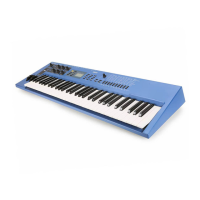22
To exit Performance Edit mode, press the PERFORMANCE
button again or the PROGRAM [-]/[+] button. You can enter Multi Play
mode directly from Performance mode by pressing the MULTI button.
Edit Mark
Once you have edited a Performance in any way, an edit mark (a
reversed type letter "E") will appear to the left of the Performance
number. This mark indicates you have edited, but not stored the
Performance.
The edit mark will also appear simply by making a slight
position change to a Sound Control Knob (see page 6).
● Description of Each Function
Common Edit 1 (applied to all Layers)
This row provides functions and parameters which are common
to all Layers in a Performance, such as the Arpeggiator, and the
Performance Level, Effect and Name.
■ ARPEGGIATOR
The Arpeggiator automatically creates arpeggiated chords
based on the chords/melodies you play on the keyboard. There
are three Arpeggiator parameters: TYPE, TEMPO and SUBDIVIDE.
PERFORMANCE MULTI
DEMO
STORE UTILITY
TYPE
BANK
P BEND
RANGE
NOTE
SFT
ATK
TIME
ATK
TIME
TEMPO
ARPEGGIATOR PERFORM
LEVEL
EFECT
PROGRAM
SYSTEM MIDI ASSIGN
PMOD
DETUNE
DCY
TIME
DCY
TIME
SUB
DIVIDE
VOLUME
FMOD
REV
TYPE
CUTOFF
FC PORTA
VEL ASSIGN2
LFO
PEG
CHO
TYPE
VARI
EF
VARI
TYPE
SWITCH
VARI
PARAM
TIME
VARI
DATA
MW
FMOD
LIMIT
LOW
TUNE
AEG
FEG
NOTE
DCY
LEVEL
DCY
LEVEL
PAN
CUTOFF
LIMIT
HIGH
REL
TIME
REL
TIME
REV
SEND
LIMIT
LOW
AMOD
INIT
LEVEL
CHO
SEND
LIMIT
HIGH
PMOD
ATK
TIME
EFFECT
VARI
SEND
OFFSET
FMOD
ATK
LEVEL
CUTOFF
FILTER
DEPTH
WAVE
DCY
TIME
REZ
PARAM
SPEED
REL
TIME
PERFORM
NAME
POLY/
MONO
ASSIGN1
PARAM
DATA
PHASE
INIT
REL
LEVEL
COMMON
LAYER
Indicates you have edited,
but not stored the Performance.
You can also use the numeric keypad (0~9) or the Data
Entry knob to change the value.
To change the value for all four Layers at one time, hold
SHIFT and press the Parameter Value UP/DOWN button. When you
press SHIFT in Performance Edit mode, a letter "A" (All) will appear in
the LCD below the word "LAYER".
Each voice is preset with optimum settings for the parameters,
and the value you set for any parameter will offset (add or subtract) the
preset value. If the value of a parameter exceeds the maximum or
minimum limit available, the highest or lowest value will be used.
The actual value is the sum of the value displayed in the
LCD and the value set by the Sound Control Knob.
The original voice can be restored and heard by returning
to Performance Play mode and moving the Sound Control Knob to the
center position.
You can replace the voices currently assigned to each Layer
with new voices or assign a voice to an empty Layer (up to four
voices/Layers for a Performance).
5. Set the other parameters.
As you continue pressing the other Parameter Value UP/DOWN
buttons, the other parameters will appear in the display. Set the other
parameters to your preference.
6. Store the Performance.
When you have finished editing, store the Performance as a User
Performance. For details about how to store a Performance, see page 44.
The edited contents will be retained in memory even if you
turn the power off during an edit. The Performance you were editing
will still be selected the next time you turn the power on, and you will
be able to pick up from where you left off and continue editing the
Performance.
While editing a Performance, if you select another
Performance or press the PERFORMANCE button again to exit
Performance Edit mode before you have first stored the data as a
User Performance, your edited data will be lost. For details about
storing a User Performance, see page 44.
PERFORMANCE MULTI
DEMO
STORE UTILITY
TYPE
BANK
P BEND
RANGE
NOTE
SFT
ATK
TIME
ATK
TIME
MASTER
TUNE
TEMPO
ARPEGGIATOR
PROGRAM
SYSTEM
PMOD
DETUNE
DCY
TIME
DCY
TIME
KBD
TRANS
D
VO
F
L
TUNE
AEG
FEG
L
L
C
ARPEGGIO
HOLD SHIFT
OCTAVE
PART/LAYER/
+
PRESET USER
PROGRAM
+

